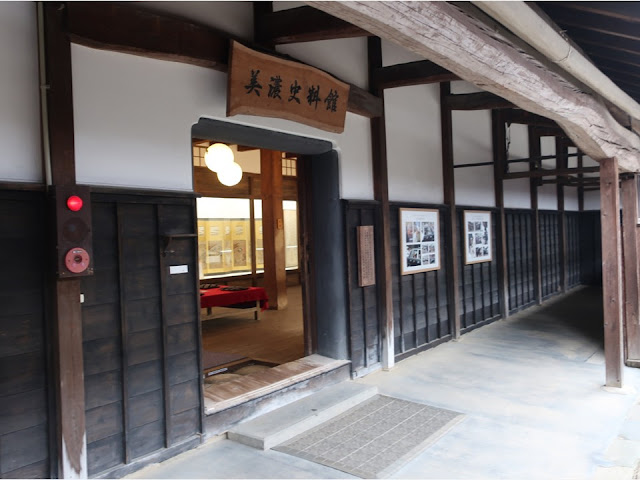Link of part 1 of this article is below, which is mainly about Mino Washi Akari Art. Mino City prospered as a commercial district of Japanese paper (washi).
Old
town of Mino City and its museums (1/2)、美濃の町と資料館(part1)
Part 1は町並みと美濃和紙あかりアートの記事です。美濃は高級和紙の集積地として栄えた町です。
Ex-Imai residence and Mino museum、旧今井家住宅・美濃史料館
The stone with a hole at the entrance was used to hitch a horse.
玄関脇には馬つなぎ石があります。鉄輪をつけるのではなく、石に穴を空けています。
It is a view of the street from inside the house, which is a business space.
家の中から見た表通り。商売のスペース「みせ」(帳場)です。
The brazier and floor cushions (zabuton) are set at the business space for talking with a customer.
接客火鉢が置かれています。簡単な商談はここで済ませたのでしょう。
There is a curtain between the business space and the inner one.
店の奥とは暖簾で仕切られています。
The inner room (oku-zashiki) faces to a court.
奥座敷は中庭通じています。
There is a special equipment at the court; buried earthen jar that makes a musical sound when water drips into it (sui-kin-kutsu). It sounds well! It is designated as one of “100 Soundscapes of Japan”. (You can hear the sound on the movie above)
中庭の水琴窟は、素晴らしい! 日本の音風景100選に選ばれています。竹の筒をつけている所が多いのですが、筒なしなのによく聞こえます。(上の動画で音を聞けます)
The wooden machine (lower right) in the kitchen was used to make pressed sushi. In Inuyama city near Mino, it was a particular sushi which was made during a celebrative day such as a festival. Sushi rice, mackerel, lotus root and other ingredients pressed in the boxes ( Inuyama Castle and museums(1/2)). Memories of family was probably packed at the same time.
竈がある土間に、さりげなく押し寿司を作る木箱が置かれていてビックリしました。近くの犬山では、犬山祭などハレの日に、鯖の他にレンコンや角麩を入れて押し寿司を作ったそうです(犬山城と城下の資料館(1/2) )。人びとがいろいろな事情と思いで調理してきた場所なんですね。
There are four fire-proof storage behind the residence; those are buildings of Mino museum. In the storage above, a funny show which is held at Mino Festival is exhibited.
土間を抜けると蔵が4つ。美濃史料館になっています。「にわか蔵」では美濃祭りの夜に行われる美濃流し仁輪加(にわか)が紹介されています。
In the evening, towners draw a cart and play a funny show at street corner. In 2025, it was held on the 12th of April (Saturday). It is said that Mino washi paper merchants who went to Edo, Kyoto or Osaka, introduced the performance.
太鼓を乗せた荷車を引いて、街角で寸劇を行うコントですね。2025年は4月12日に催行されました。江戸や京阪で取引をしていた美濃の紙商人が伝えたといわれています。
A script is displayed. It is a modern comedy. If your friends play, I’m sure you are in stitches.
台本が展示されていました。現代コントですが、知っている人が演じると大爆笑になると思います。
動画:https://www.youtube.com/watch?v=cW34lh2yge4
Old photos are exhibited at the ex-storage.
奥の蔵の2階では古い写真が展示されています。
The photo was taken in Kouduchi festival in 1911; it is an origine of Mino Festival. Most of all spectators wore kimono (Japanese traditional clothes).
明治44年の上有知祭り。美濃祭りのルーツです。見物人はほとんど着物ですね。
A boy on the right sees the parade from the roof; it’s a premium seat! We watched an event such as firework on roof. I remember the roof tiles were warm.
庇の上で見物している子どもがいます。屋根の上は特等席ですね。かつては、屋根の上で花火を見るということもありました。瓦が温かかった記憶があります。
A boy is jumping into Nagara River; it is near the river port.
川湊の近くで、長良川に飛び込む子どもが写っています。
The water is pure even now. However, there is a banner at the left levee which says “Swimming is dangerous! You will be drawn into a whirlpool!” I was relieved that swimming was not prohibited. There was a river port inside the white dot circle.
今も水がきれいですが、長良川の堤防には「遊泳危険!渦に引き込まれるぞ!」の横断幕が出ています。禁止じゃなくてよかった。一方、夕方の川原では、テントを立てサウナを楽しんでいた人もいました。破線の枠内が川湊跡です。
It is a site of an ex-port in Kouduchi; washi paper manufactured in Mino region was unloaded. The lighthouse built in the mid-19th century remains. However, the river port finished its role after the railway was operated in the early 20th century.
美濃で作られた和紙が運び込まれた上有知川湊跡。江戸末期に建てられた灯台が残っています。明治末年に電車が通るとその役目を終えました。
史料館に展示されている古地図にも川湊がある川原が描かれています。美濃町は、畑の中に建てられた町だったのですね。
Visited in May, 2024
Previous post (part 1 of this article, mainly about Mino Washi Akari Art): Old town of Mino City and its museums (1/2)、美濃の町と資料館(part1)
Next post (open air architectural museum in the neighboring prefecture): Meiji Mura、博物館 明治村
















Comments
Post a Comment